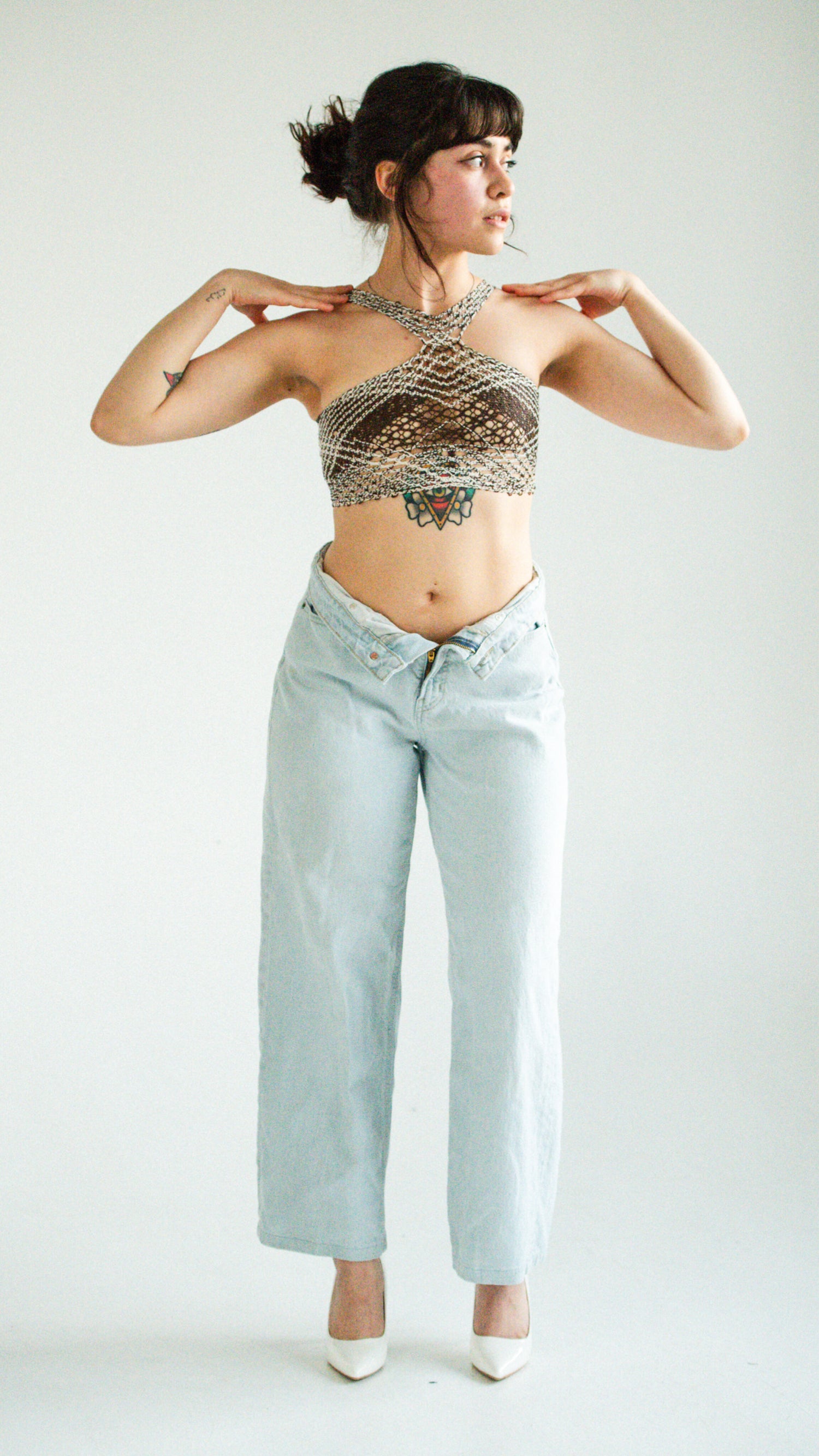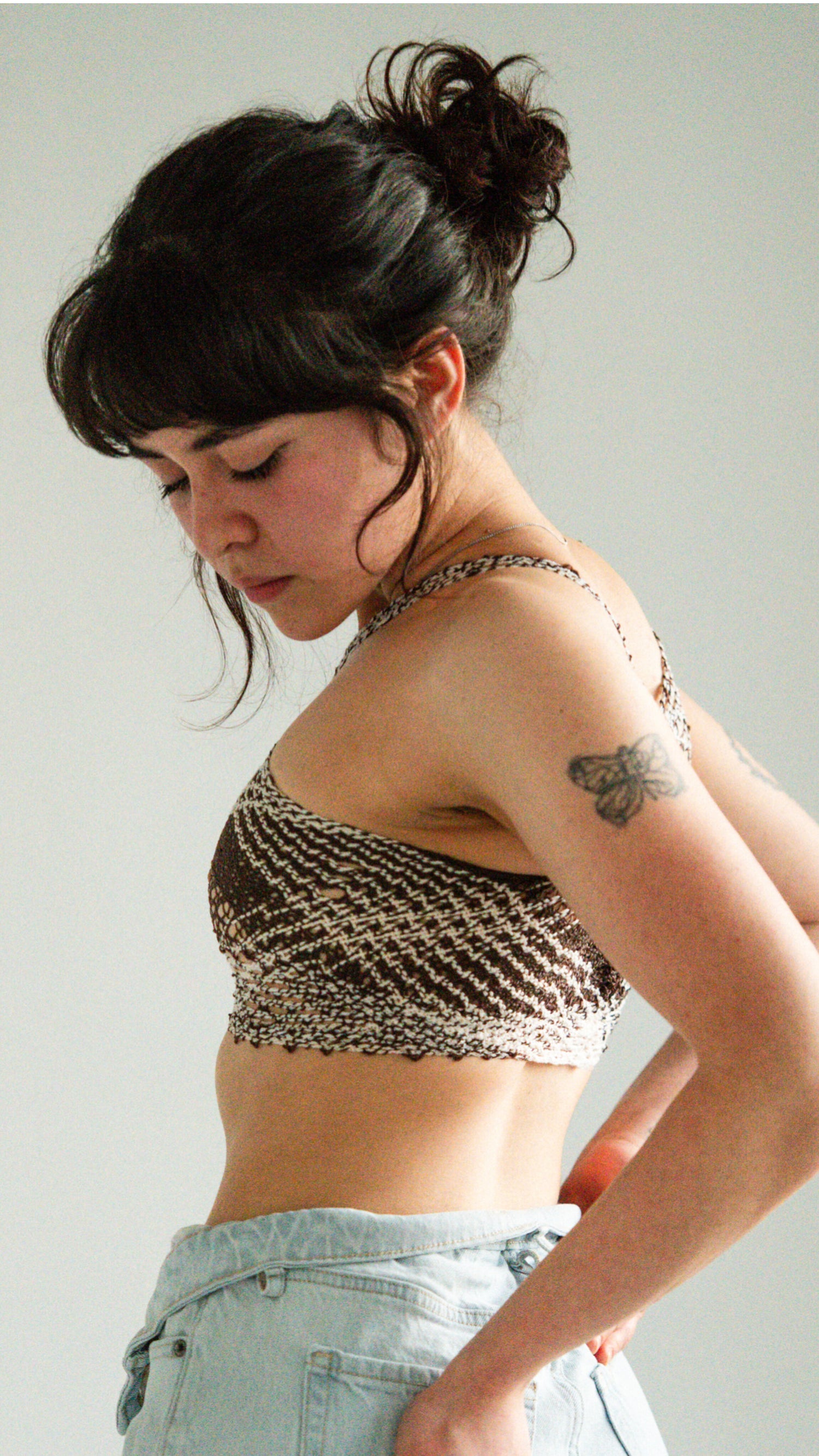By embracing the dynamic nature of braided textiles, we explore the intersection of technology, sustainability and design.
Our design for a "perfect" sports bra is based on holistic integration, where all elements function in unison as part of a connected system. Our holistic method of design and manufacture produces a product that mimics natural systems that are flexible, responsive, and capable of change over time, demonstrating the dynamic, synergistic functionality that is possible with within a unified filament structure that is patterned for performance.
Our design philosophy draws inspiration from nature’s ability to balance forces and distribute tension efficiently. Just as the fibers of a spider’s web or the branching structure of a tree manage stress to avoid breakage, we apply these principles of balanced tension to our sports bra design. Our complex yarn networks having a fluid, unbound architecture, adapts in real-time to the body’s movements, shifting to balance and distribute the forces caused by breast motion. This biomimetic approach reduces discomfort and strain by offering support where it’s needed most, while allowing flexibility in other areas.
Breast motion studies, when viewed through the lens of biomimicry, provides valuable insights into the behavior of our sports bra design. Breast motion, especially during physical activities like running or high-impact sports, involves complex movement patterns. The breasts move in three-dimensional ways—up and down, side to side, and in a rotational motion. Traditional sports bras often focus on minimizing motion, but this can sometimes restrict natural movement and cause discomfort. Akin to how natural systems—such as plant fibers, animal tendons, or even the human skin—manage motion, our yarn patterning design system provides evolving support without limiting or restricting.
Our bras are created using a simultaneous yarn-to-product braiding manufacturing method that forms a patterned, unbound network of unified yarns. This innovative filament geometry allows the fabric to "respond" to motion, tightening in areas where more support is needed and loosening where less tension is required. By adapting in real-time to the wearer’s unique motion, the braided bra can provide a personalized and holistic fit that evolves with the body’s needs.

Our work highlights the potential of "Patterned Material-Process Driven Design" where the yarn pattern and process of creating textiles directly influences the final form and functionality.
Our Patterned Material-Process-Driven Design (PMDD) emphasizes the value of a material's inherent behaviors. Behavior is the consequence of patterned yarn topology. Different typologies dictate varying performance properties, and aesthetics. This material-process driven design provides a much-needed perspective for the textile and fashion industry as it moves toward more sustainable and circular systems.

Braided fabric offer key advantages over traditional knit or woven textiles:
Strength & Durability:
Braided fabrics are inherently stronger due to their interlaced structure, making them ideal for high-stress-strain applications like sportswear and industrial textiles.
Flexibility & Stretch:
The braiding process provides natural elasticity, allowing the fabric to adapt to body movements, which is beneficial for garments like sports bras or compression wear.
Customized Performance:
Braided textiles can be engineered for specific properties like tension distribution, breathability, or insulation.
Zero-Waste Production:
The continuous yarn-to product process minimizes waste, supporting sustainable production practices compared to cut and-sew methods.
Enhanced Comfort & Fit: Braided fabrics conform to the body more closely, providing fluid, conformal fit when under tension.
Aesthetic Flexibility:
Braiding allows for intricate, customizable patterns having diverse performance characteristics.
Flower of Life Yarn Architecture
The fabric of this bra is based on the "Flower of Life", a symbol of sacred geometry representing interconnectedness. Built as a 3D textile the linked and interlaced network of this pattern provides dynamic support without limiting or restricting movement. This "multimorphic" geometric approach to product design produces textiles that perform naturally with fewer ingredients and less complexity. This "Flower of Life" fabric is a step toward developing fabrics that mirror living organisms and an example of "Patterned Material-Process-Driven" design.

Programmable braiding technology aligns with holistic design principles by considering the entire lifecycle of a product, from material selection to construction. This method of manufacture enables the creation of complex, multifunctional textile structures that offer precision, adaptability, and integrated performance—qualities traditional cut-and-sew methods cannot match. By optimizing material use, programmable braiding ensures a more efficient, environmentally-friendly production process.





